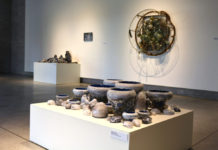On Aug. 23, Ryerson University’s Board of Governors voted in favour of changing the university’s name. Egerton Ryerson, the University’s namesake, was a key figure in the creation of the residential school system. As such, Indigenous activists have called for the university, often referring to it as “X University,” to change its name and remove references to Ryerson for several years. Following the discovery of unmarked graves at various residential school sites, the statue of Ryerson at the university was torn down by protestors and the university formed the Standing Strong (Mash Koh Wee Kah Poo Win) Task Force, which eventually advocated, among 21 other recommendations for reconciliation, for the university to change its name.
In light of the controversy at Ryerson University, the community might be curious about where the names on the University of Waterloo campus come from. So here it is — a brief overview of the people behind the names on campus.
B.C. Matthews Hall (BMH) – Burton Clare Matthews (1926-2004) served as president and vice-chancellor of UW from 1970 to 1981. He was a trained soil scientist who also served as president and vice-chancellor of the University of Guelph from 1983 to 1988.
Carl A. Pollock Hall (CPH) -– Carl Arthur Pollock (1903–1978) was a successful local businessman, the founder of CKCO – a local TV station that’s been on the air since 1954 — and one of the founding members of the UW Board of Governors.
Claudette Millar Hall – Claudette Millar (1935–2016) served as mayor of Preston from 1969, at the time the youngest mayor in Canada at 35 years old, until 1973 when Preston, Galt, Blair and Hespeler municipalities were amalgamated into the city of Cambridge and Millar was elected Cambridge’s first mayor. Millar served as mayor of Cambridge from 1973 to 1974 and again from 1978 to 1988. She was then elected to the Ontario Municipal Board, where she served until her retirement in 2014.
Conrad Grebel University College – Conrad Grebel (1498–1526) is considered one of the major founders of Swiss-South German Anabaptism.
Dana Porter Library (DP) – Dana Porter (1901-1967) served as UW’s first chancellor from 1960 to 1966. Previously, he fulfilled several roles in provincial government during his time as an Ontario MPP in the Conservative Party of Canada from 1943 to 1958. He stepped down in 1958 to become chief justice of the Ontario Court of Appeals under John Diefenbaker’s federal government, a post he held until shortly before his death.
The Davis Centre – William “Bill” G. Davis (1929–2021) was Minister of Education under John Robarts from 1961 to 1971, and succeeded him as the 18th Premier of Ontario from 1971 to 1981.
Douglas Wright Engineering Building (DWE) – Douglas Tyndall Wright (1927–2020) served as UW’s first dean of engineering from 1959 to 1966 and UW’s third president and vice-chancellor from 1981 to 1993. He was a trained civil engineer and was awarded the Order of Canada in 1991.
Ira G. Needles Hall (NH) – Ira George Needles (1893-1986) helped to found UW in 1957. During the development of the university’s programs, Needles, a successful local businessman, put forward the ideas that would become the co-operative education program in a 1956 presentation. Needles further served as chairman of the university’s Board of Directors from 1956 to 1966, following which he succeeded Dana Porter to become UW’s second chancellor from 1966 to 1975.
J.G. Hagey Hall of the Humanities (HH) – Joseph Gerard “Gerry” Hagey (1904–1988), along with Ira Needles, founded UW. The two men were previously colleagues at B.F. Goodrich Canada, and they reunited in 1956 to found UW and bring their view for co-operative education to life. Before co-founding UW, Hagey was elected president of Waterloo College (now Wilfrid Laurier University) in 1953. He was part of plans to open a new science campus for the college in 1957, which, coincidentally, occurred around the same time as Needles’ 1956 speech. After the newly completed science and engineering facilities became independent from Waterloo College, Hagey became UW’s founding president from 1957 until 1969, when he lost his larynx in the battle against cancer. Hagey was awarded the Order of Canada in 1986.
J.R. Coutts Engineering Lecture Hall (RCH) – J. Roderick Coutts earned his bachelor’s degree in electrical engineering in 1964, one of UW’s first graduates from the program. He went on to co-found Teklogix, a tech company focused on automation and real-time wireless data capture, in 1967. UW’s engineering lecture hall building was renamed in his honour in 2000, following a $7 million donation to UW from Coutts, whose company had just been sold to Psion PLC, a manufacturer of mobile computers based in London, England.
Lyle S. Hallman Institute for Health Promotion (LHI) – Lyle Shantz Hallman (1922-2003) was a successful real estate developer and philanthropist, in particular toward education and healthcare. He served as Governor of the Kitchener-Waterloo Hospital Foundation and was a founding member of Conrad Grebel College’s Board of Directors. He donated $6.5 million to the construction of what would become the LHI building.
Mackenzie King Village – William Lyon Mackenzie King (1874–1950) was the leader of the Liberal Party from 1919 to 1948, and served as Canadian prime minister from 1921 to 1930 and again from 1935 to 1948.
Mike and Ophelia Lazaridis Quantum-Nano Centre (QNC) – Mikhail “Mike” Lazaridis and Ophelia Wai Fong Lazaridis have both volunteered their time with UW leadership committees and have provided funding for several cutting edge research institutions on campus. Mike dropped out of UW two months before graduating and ultimately received an honourary degree in 2000. Ophelia graduated in 1985 with a bachelor’s in math. Mike founded BlackBerry (Research in Motion) in 1984, as well as the Perimeter Institute for Theoretical Physics and the Institute for Quantum Computing, both of which are housed within the Quantum Nano Centre.
Renison University College – The Most Reverend Robert John Renison (1875–1957) immigrated from Ireland to Canada in 1880. He spent much of his career as a missionary in Northern Ontario and was fluent in Cree. He served as Bishop of the Dioceses of Moosonee from 1944 until 1952 and as the ninth Metropolitan (Head Bishop) of the Ecclesiastical Province of Ontario from 1952 until 1954.
Ron Eydt Village – Henry Ronald North “Ron” Eydt (1932–2018) was a trained botanist who had several roles within UW’s biology department and served as UW’s warden of residences from 1964 to 1996.
William M. Tatham Centre for Co-operative Education and Career Action – William M. “Bill” Tatham graduated from UW with a bachelor’s of applied science degree in 1983 and has long credited co-operative education as the foundation for his professional success. Tatham founded Janna Systems in 1990, which he sold to Siebel Systems for $1.76 billion in 2000. He is also the founder and executive chair of NexJ Systems Inc. Tatham has been a regular financial supporter of UW, including donating $4 million to the co-op program, and is a vice-chair for Campaign Waterloo in addition to being a member of the advisory board of the Waterloo Institute for Health Informatics Research.
































